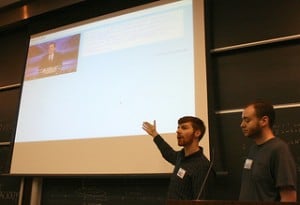How a Prof Used 1 Tech Tool to Build 3 Co-Learning Spaces
“How a Prof Used 1 Tech Tool to Build 3 Co-Learning Spaces” by Jennifer Funk first appeared on the Edcetera blog.

Student presentations, like many rituals of teaching and learning, have changed very little over the years. But when technology transformed the way artists, entrepreneurs, and…well, anyone…presented their work and ideas, it was only a matter of time until student presentations got a similar makeover.
Yet, it’s important to remember that it’s not about the technology.
Howard Rheingold says it well.
“The underlying methodology is enabled by the technology, but the methodology is what is important — giving students a means to continue discursive inquiry beyond the classroom, to tap into worldwide networks of knowledge and expertise, and to talk among themselves instead of speaking when called upon by the professor.”
This is the pedagogy of what Rheingold calls co-learning.
Though he doesn’t use the term to describe his own teaching, Mark Frydenberg, a computer information systems professor at Bentley University in Waltham, MA, builds co-learning spaces.
When he flips through his mental Rolodex of web-based collaborative tools to build a new space, he starts with the methodology.
Once, he wanted students to research a topic, share their findings and build upon each others’ ideas. Another time, he wanted them to learn alongside their peers an ocean away who were studying similar concepts. Then there was the time he wanted a way for the university’s incoming students to get to know each other.
He’s determined one tool, in particular, enables each methodology: VoiceThread.
What is VoiceThread?
VoiceThread is a platform that re-imagines student presentations as a “conversation in the cloud” by allowing educators to upload slideshows, video and other media to the web and letting students add text, audio and video comments.
Since it enables asynchronous communication, many use it in their online classes, but Frydenberg realized that this kind of communication would add an extra dimension to his on-campus courses.
So, he signed up for a free account that allowed him and his students to publish presentations and share them with each other.
Everyone with access to a VoiceThread presentation was able to contribute his or her thoughts and view and build upon classmates’.
This feature, in particular, made VoiceThread a go-to tool for constructing Frydenberg’s co-learning spaces.
3 Models for VoiceThread as a Co-Learning Space
#1: The Collaborative Lecture
Frydenberg wanted students in his information technology class to teach each other about cloud computing, so he uploaded to VoiceThread a slideshow with topics like cloud services, cloud players and cloud security.
Then, he asked students to research these topics and add two comments to two different slides keeping their comments limited to 30 seconds or less and requesting that no one slide have more than eight comments.
Further, he asked students to build upon each other’s comments and add text hyperlinks to resources that supported their information and opinions.
The resulting comments were informative and succinctly expressed.
“Hi, this is David and I’m going to talk about the fifth generation of computing and how it relates to artificial intelligence…” begins one student.
Another adds, “Hey, this is Greg and I’m going to talk about what the fifth generation of computing means to us. David mentioned AI but there’s a lot more that comes about with this fifth generation…”
Frydenberg said he liked this model because he discovered what his students thought was important but was still able to go back and talk about details that were left out and clarify comments that missed the mark.
View the entire collaborative lecture here.
#2: The Real-World Work Product
In another case, Frydenberg and Diana Andone, a colleague at the University of Timisoara in Romania, wanted to teach their students about the difference between synchronous and asynchronous communication through a collaborative project.
For a month, teams of two American students and two Romanian students researched up-and-coming Web 2.0 startup companies. They used synchronous communication, like Skype, Google+ Hangouts or Gmail chat, and asynchronous communication, like email and a wiki, to discuss and share ideas about their assigned companies.
They then created a slideshow and used VoiceThread to tell others what they learned.
Frydenberg liked this model for its resemblance to the real-world work environment of today’s technology professionals.
“[My colleague and I were] putting students in a controlled environment that models the work environment they’re most likely going to enter as information technology professionals,” Frydenberg says. “They’ll have to work with international partners at a company’s office overseas to create a real, tangible work product in a short amount of time.”
View one group’s project here.
#3: The Non-Academic Ice Breaker
As the director of the CIS Sandbox, an on-campus learning lab, Frydenberg used VoiceThread during the campus open house to introduce incoming students to each other.
When students visited the Sandbox they were invited to sit down at a computer in front of a web camera and add their comments to a VoiceThread presentation.
One by one, students completed sentences like, “I’m on Twitter because…” or “I’m not on Twitter because…” and answered questions like, “Are you worried about your privacy online?”
When they returned to their dorms, they were able to visit the link provided to them and view other students’ answers to the same questions.
View the entire presentation here.
If you’ve used VoiceThread, share below the models that work for you.



0 Comments
Leave a Comment
Your email address will not be published. All fields are required.